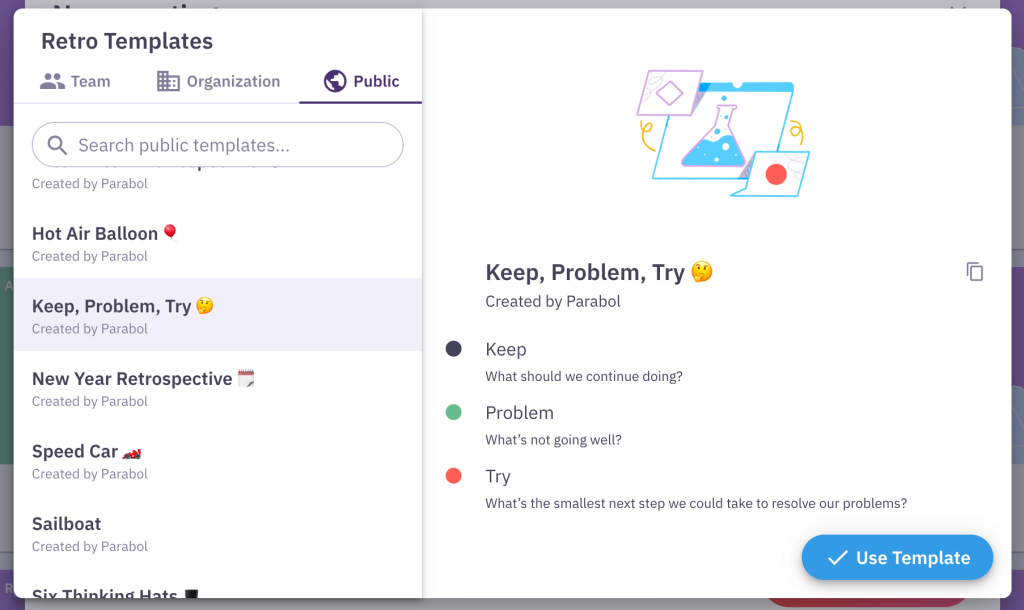Keep Problem Try (KPT)
A simple, action-focused retrospective to help you improve

What is a Keep Problem Try retrospective?
Keep Problem Try (KPT) is more than a meeting template. It’s a way to learn from how you’ve worked in the past, and use that to do better going forward. Your team will look closely at what served you well, what posed a challenge, and how you could change up your work in fresh, exciting ways.
KPT was originally invented by Alistair Cockburn, one of the co-authors of the agile manifesto.
Today, it’s especially popular in Japan among software and product teams and has been used by Toyota. Some even attribute it to Toyota rather than Alistair Cockburn.
Keep Problem Try retrospective prompts
Here are the prompts for a Keep Problem Try retrospective meeting:
Keep
What made this past sprint or project exceptional? What do you want to keep doing, or do even more of?
Some items to keep will probably come to mind right away. For example, you’ll be excited to talk about techniques that led to major wins, or risky experiments that paid off.
But don’t forget the things that work so well you might not even notice them anymore! You definitely want to keep the processes that are a key part of your workflow, so it’s worthwhile to talk about them, too.
If one of your team members was responsible for the good things you’d like to keep, this is the time to personally thank them!
Example: I really love our flexible working days. Having the option to start a little later, or take a longer lunch, helps me make sure I’m always working at my best.
Problem
It’s great to know what works. But it’seven more valuable to analyze what went wrong.
For this prompt, everyone will share the problems and tough situations they ran into. Those don’t have to be big, scary obstacles. Small, personal challenges have a lot to teach us, too.
If you found a way to solve these problems, you could share that now. Potential solutions you haven’t tried out yet should be saved for the next prompt.
Example: My anxiety and insomnia have been impacting my ability to work. I’ve talked to my doctor, but I’m not really sure where to go from here.
Try
This part of the retro is a little more forward-facing. What do you want to try out in the future?
These could be possible solutions to the issues you discussed above. But they can also just be ideas, techniques, or approaches that you’re generally curious about.
It’s great to think boldly and creatively here, so don’t hold back. But, try to keep your ideas as concrete and specific as possible.
Discuss the feasibility of each thing you’d like to try with your colleagues. How would you actually put them into action? Work together to create a plan or action items to bring some of them to life.
Example: Sometimes, it feels like a rush to get my work approved before we send it off to the client. What if we built a 48-hour editing period into our deadlines?
When to do a Keep Problem Try retrospective
Try a KPT sprint retrospective when you need to do a spot of sprint cleaning or when you want a simple and battle-tested retrospective to run with your team.
When you need to change things up
KPT is all about the specifics of how you work. This retrospective isn’t for discussing the big picture, or your teammates’ personal experiences and feelings.
Break out this retro when you really want to hone in on what’s working, what’s not, and how you could change it up.
To keep it simple
KPT gets right to the heart of agile methodology, and striving for continuous improvement.
Creative, metaphorical retrospectives can be a lot of fun. But when you need to get back to basics, this retrospective could be just the thing.
How to run a Keep Problem Try retrospective in Parabol
Sign up to Parabol for free retrospectives. Then, from your Parabol dashboard hit the Add New Meeting button.
Select the Keep Problem Try (KPT) retrospective template
Select Retro Meeting with the arrows, then use the dropdown to select the Keep Problem Try retrospective.

Here’s where you can find all of Parabol’s built-in retrospective templates, including other learning focused retrospectives such as start stop continue, mountain climber retrospective, and the what went well retrospective, among other retrospective ideas. Why not bookmark one of these for your next retrospective?
When you’re ready, the facilitator should hit Start Meeting to kick things off!
Start your Keep Problem Try retro with an Icebreaker
The Icebreaker box is checked on by default. You don’t have to do one, but we recommend it. A good icebreaker is the prelude to a great retrospective and can loosen everyone up.
Why not ask your team-mates what’s a new hobby or skill they’d like to try in their personal lives?
If you’re doing an Icebreaker, you’ll have a random question to answer. You can refresh it if you want another option, and of course you can create your own if you want.

Next, you’ll reflect on your work together using the KPT prompts.
Remember, Parabol is a remote-friendly online retrospective tool that enables you to run asynchronous retrospectives with your team.
Reflect, Group, and Discuss topics based on the Keep Problem Try prompts
After the reflect phase, you’ll vote on issues to discuss, talk about the most voted on items, and then get a summary of the retro when you’re done.
Parabol is remote-friendly, enabling you to work asynchronously with your team. Your scrum team can all leave comments synchronously, or do it at a time that works for them.
Also, reflections are anonymous, and no one can see them until you’re done working on them.
After the reflect phase, you’ll vote on issues to discuss, talk about the most voted on items, and then get a summary of the retro and any action items when you’re done.